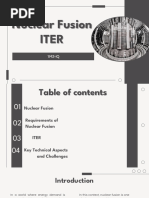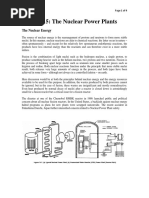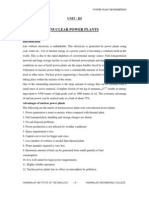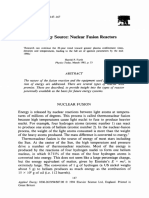J04010 01-7983 PDF
J04010 01-7983 PDF
Uploaded by
salutCopyright:
Available Formats
J04010 01-7983 PDF
J04010 01-7983 PDF
Uploaded by
salutOriginal Title
Copyright
Available Formats
Share this document
Did you find this document useful?
Is this content inappropriate?
Copyright:
Available Formats
J04010 01-7983 PDF
J04010 01-7983 PDF
Uploaded by
salutCopyright:
Available Formats
International
OPEN ACCESS Journal
Of Modern Engineering Research (IJMER)
A Technology Review of Electricity Generation from Nuclear
Fusion Reaction in Future
1
Joydeep Sarkar, 2Karishma P. Patil, 3Kedar Pimparkar
1, 2
Department of Electrical Engineering, Sandip Institute of Engineering & Management, Nashik, India
3
Department of Mechanical Engineering, Dnyanganga college of Engineering and Research, Pune, India
Abstract: In this review paper, we have tried to revisit the basic concept of nuclear fusion and the recent
thrust that has been witnessed in the recent times towards power generation from it . In fusion we get the
energy when two atoms fused together to form one atoms. With current technology the reaction most
readily feasible is between the nuclei of the deuterium (D) and tritium (T). Each D-T releases 17.6 MeV of
energy. The use of nuclear fusion plant will substantially will reduce the environmental impacts of
increasing world electricity demands. Fusion power offers the prospect of an almost inexhaustible source of
energy for future generation but it also presents so far insurmountable scientific and engineering
challenges.
Keywords: Deuterium, Nuclear fusion, ITER, Plasma Confinement, Tokamak Reactor, etc
I. INTRODUCTION
In the present scenario of world, each day need of electricity is increasing day by day. We found out
different methods to generate electricity. But due to large population of the world the present sources are not
that much sufficient. Also there is some pollution problems related with present electricity generation
techniques. Therefore, as a long term research and experimental solution of this problem, ITER has been
developed to generate the power from nuclear fusion. In fusion reaction, two nuclei joins together to form bigger
nuclei along with this large amount of energy is liberated. Then this energy can be used to rotate the turbine and
can eventually possible to generate electricity. The process of nuclear fusion will takes place between the nuclei
of deuterium and tritium.
Research in fields of nuclear fusion has been pursued in various countries for decades. The efforts
include the JT-60, which has provided important results for improving plasma confinement; the D-IIID
Tokamak experiment, which has achieved record values of plasma pressure relative to the magnetic field
pressure; and the Tokamak Fusion Test Reactor (TFTR), which has generated 10 million Watts of thermal
power from fusion. The Joint European Torus (JET) is expected to approach breakeven Conditions, where the
fusion power generated exceeds the input power. Unresolved physics Issues, such as plasma purity, disruptions,
and sustainment of current, should be resolved by the International Thermonuclear Experimental Reactor
(ITER).This is being designed by experts of the European Community, Japan, Russian Federation, and the
United States.
II. SCIENCE BEHIND FUSION ENERGY
For some decades, people have looked to the process powering the sun – nuclear fusion –as an answer
to energy problem on the earth. Nuclear fusion is the process of binding nuclei together to form heaver nuclei
with release of large amount of energy. It is the process that powers the star and of course our own sun. In the
process of fusion, atomic nuclei do not stick together easily. It is because there is electromagnetic force present
between the two nuclei. . However, at distances of 1015 m there is an attractive force which acts on the nuclei to
keep them together and it is much stronger than the electromagnetic force. Appropriately, this force is called the
Strong force.
Over such short distances the strong force wins over the electromagnetic force and so the nuclei stay
together. To create a situation where the nuclei have sufficient energy to overcome the electromagnetic force
requires the nuclei to have extremely high kinetic energy and therefore, a high temperature. We can estimate
the temperature required to initiate fusion by calculating the Coulomb barrier which opposes the protons coming
together. The magnitude of the force between protons is given by:
F= (k q1 q2)/r2 ; k=1/(4πε0) is the Coulomb constant = 8.988×109 m/F
| IJMER | ISSN: 2249–6645 | www.ijmer.com | Vol. 4 | Iss.10| Oct. 2014 | 79|
A Technology Review of Electricity Generation from Nuclear Fusion Reaction in Future
The work done, U in moving the two protons together until they are attracted by the strong force is given by:
U=∫F.dr= (k q1 q2)/r0 ; the limits on the integration are -∞ and r0
The Coulomb barrier increases with increasing atomic number:
U= (k Z1 Z2 q2)/r0. ; Z1 and Z2 are the proton numbers of the nuclei being fused.
U= (8.988 x 109 x 1 x 1 x (1.6 x 10-19)2)/(1 x 10-15) = 2.298 x 10-13 J
The kinetic energy of the nuclei is related to the temperature by: 0.5 mv2 = (3/2) kBT
By equating the average thermal energy to the Coulomb barrier height and solving for T, gives a value
for the temperature of around 1.1 x 1010 K. In practice, this simple calculation overestimates the temperature.
The temperature of critical ignition should be lower because there will be some nuclei with higher energies than
average; however the temperature requirement is still too high for even these high energy nuclei. This treatment
using classic physics does not take into consideration the effect of tunneling, which predicts there will be a small
probability that the potential barrier will be overcome by nuclei 'leaking' through it.
At sufficiently high temperature, nearly all light nuclei undergo fusion reactions and could in principle
be used to fuel a fusion power plant. However, technical difficulties increase rapidly with the nuclear charge of
the reacting isotopes. For this reason, only deuterium, tritium and isotopes of helium, lithium, and boron have
been proposed in practice. The first generation of fusion power plants will very likely use deuterium-tritium
(DT) fuel because it is the easiest to ignite. The main reaction product, helium-4, does not pose a health hazard.
The principal energy output from a DT fusion event is a 14 Mev neutron. Neutron reactions in DT fusion
reactors will inevitably create radioisotopes. The principal radioactive materials present in a DT fusion reactor
will therefore be tritium and neutron activated structural materials surrounding the reaction volume. Following
fig shows that how nuclear fusion reaction takes place between deuterium and tritium
Figure 1- fusion reaction between deuterium and tritium [ ]
III. CONDITIONS FOR FUSION REACTION
When hydrogen atoms fuse, the nuclei must come together. However, the protons in each nucleus will
tend to repel each other because they have the same charge (positive). If you've ever tried to place two magnets
together and felt them push apart from each other, you've experienced this principle first-hand. To achieve
fusion, you need to create special conditions to overcome this tendency. Here are the conditions that make
fusion possible.
High temperature
The high temperature gives the hydrogen atoms enough energy to overcome the electrical repulsion
between the protons. Fusion requires temperatures about 100 million Kelvin (approximately six times hotter
than the sun's core). At these temperatures, hydrogen is plasma, not a gas. Plasma is a high-energy state of
matter in which all the electrons are stripped from atoms and move freely about.
High pressure
Pressure squeezes the hydrogen atoms together. They must be within 1x10-15 meters of each other to
fuse. The sun uses its mass and the force of gravity to squeeze hydrogen atoms together in its core. We must
squeeze hydrogen atoms together by using intense magnetic fields, powerful lasers or ion beams.
| IJMER | ISSN: 2249–6645 | www.ijmer.com | Vol. 4 | Iss.10| Oct. 2014 | 80|
A Technology Review of Electricity Generation from Nuclear Fusion Reaction in Future
With current technology, we can only achieve the temperatures and pressures necessary to make
deuterium-tritium fusion possible. Deuterium-deuterium fusion requires higher temperatures that may be
possible in the future. Ultimately, deuterium-deuterium fusion will be better because it is easier to extract
deuterium from seawater than to make tritium from lithium. Also, deuterium is not radioactive, and deuterium-
deuterium reactions will yield more energy.
IV. CASE-STUDY OF ITER
In 1985, the Soviet Union suggested building a next generation Tokamak with Europe, Japan and the
USA. Collaboration was established under the auspices of the International Atomic Energy Agency (IAEA).
Between 1988 and 1990, the initial designs were drawn up for an International Thermonuclear Experimental
Reactor with the aim of proving that fusion could produce useful energy. Then the USA decided pull out of the
project, forcing a 50% reduction in costs and a redesign. The result was the ITER – Fusion Energy Advanced
Tokomak (ITER-FEAT) – expected to cost $3 billion but still achieve the targets of a self-sustaining reaction
and a net energy gain.
Figure 2 – Magnetic Confinement Reactor – Tokamak [ ]
After deadlocked discussion, the six partners agreed in mid-2005 to site ITER at Cadarache, in
southern France. The European Union (EU) and France will contribute half of the €12.8 billion total cost, with
the other partners like Japan, China, South Korea, USA and Russia – putting in 10% each. Japan will provide a
lot of the high-tech components, will host an €1 billion materials testing facility – the International Fusion
Materials Irradiation Facility (IFMIF) – and will have the right to host a subsequent demonstration fusion
reactor. The total cost of the 500 MWt ITER comprises about half for the ten-year construction and half for 20
years of operation. India became the seventh member of the ITER consortium at the end of 2005. In November
2006, the seven members – China, India, Japan, Russia, South Korea, the USA and the European Union –
signed the ITER implementing agreement. The goal of ITER is to operate at 500 MWt (for at least 400 seconds
continuously) with less than 50 MW of input power, a tenfold energy gain. No electricity will be generated at
ITER.
A 2 GWt Demonstration Power Plant, known as DEMO, is expected to demonstrate large-scale
production of electrical power on a continual basis. The conceptual design of Demo is expected to be completed
by 2017, with construction beginning in around 2024 and the first phase of operation commencing from 2033.
Fusion Reactors: Magnetic Confinement
There are two ways to achieve the temperatures and pressures necessary for hydrogen fusion to take place:
Magnetic confinement uses magnetic and electric fields to heat and squeeze the hydrogen plasma
Inertial confinement uses laser beams or ion beams to squeeze and heat the hydrogen plasma.
In magnetic confinement, Microwaves, electricity and neutral particle beams from accelerators heat a
stream of hydrogen gas. This heating turns the gas into plasma. This plasma gets squeezed by super-conducting
| IJMER | ISSN: 2249–6645 | www.ijmer.com | Vol. 4 | Iss.10| Oct. 2014 | 81|
A Technology Review of Electricity Generation from Nuclear Fusion Reaction in Future
magnets, thereby allowing fusion to occur. The most efficient shape for the magnetically confined plasma is a
donut shape (toroid).
Figure 3 – The Nuclear Fusion Power Generation System [ ]
A reactor that uses magnetic confinement to initiate fusion is called a Tokamak. The ITER Tokamak
will be a self-contained reactor whose parts are in various cassettes. These cassettes can be easily inserted and
removed without having to tear down the entire reactor for maintenance. The Tokamak will have a plasma
toroid with a 2-meter inner radius and a 6.2m outer radius. "Tokamak" is a Russian acronym for "toroidal
chamber with axial magnetic field." The main parts of the ITER Tokamak reactor are:
Vacuum vessel - holds the plasma and keeps the reaction chamber in a vacuum
Neutral beam injector (ion cyclotron system) - injects particle beams from the accelerator into the
plasma to help heat the plasma to critical temperature
Magnetic field coils (poloidal, toroidal) - super-conducting magnets that confine, shape and contain the
plasma using magnetic fields
Transformers/Central solenoid - supply electricity to the magnetic field coils
Cooling equipment (crostat, cryo-pump) - cool the magnets
Blanket modules - made of lithium; absorb heat and high-energy neutrons from the fusion reaction
Diverters - exhaust the helium products of the fusion reaction
The fusion reactor will heat a stream of deuterium and tritium fuel to form high-temperature plasma. It
will squeeze the plasma so that fusion can take place. The power needed to start the fusion reaction will be about
70 megawatts, but the power yield from the reaction will be about 500 megawatts. The fusion reaction will last
from 300 to 500 seconds. (Eventually, there will be a sustained fusion reaction.) The lithium blankets outside
the plasma reaction chamber will absorb high-energy neutrons from the fusion reaction to make more tritium
fuel. The blankets will also get heated by the neutrons. The heat will be transferred by a water-cooling loop to a
heat exchanger to make steam. The steam will drive electrical turbines to produce electricity. The steam will be
condensed back into water to absorb more heat from the reactor in the heat exchanger. Initially, the ITER
Tokamak will test the feasibility of a sustained fusion reactor and eventually will become a test fusion power
plant.
V. APPLICATIONS OF FUSION
The main application for fusion is in making electricity. Nuclear fusion can provide a safe, clean
energy source for future generations with several advantages over current fission reactors:
Abundant fuel supply - Deuterium can be readily extracted from seawater, and excess tritium can be made
in the fusion reactor itself from lithium, which is readily available in the Earth's crust. Uranium for fission is
rare, and it must be mined and then enriched for use in reactors.
Safe - The amounts of fuel used for fusion are small compared to fission reactors. This is so that
uncontrolled releases of energy do not occur. Most fusion reactors make less radiation than the natural
background radiation we live within our daily lives.
| IJMER | ISSN: 2249–6645 | www.ijmer.com | Vol. 4 | Iss.10| Oct. 2014 | 82|
A Technology Review of Electricity Generation from Nuclear Fusion Reaction in Future
Clean - No combustion occurs in nuclear power (fission or fusion), so there is no air pollution.
Less nuclear waste - Fusion reactors will not produce high-level nuclear wastes like their fission
counterparts, so disposal will be less of a problem. In addition, the wastes will not be of weapons-grade
nuclear materials as is the case in fission reactors.
NASA is currently looking into developing small-scale fusion reactors for powering deep-space
rockets. Fusion propulsion would boast an unlimited fuel supply (hydrogen) would be more efficient and would
ultimately lead to faster rockets.
VI. CONCLUSION
The Thermonuclear reactor based on fusion can prove to be a huge step towards a massive source of
energy, if the technologies developed for the research works practically as it is expected in this large scale and
the setup handles that much energy without damaging the reactor. The ITER project has opened many areas of
fundamental studies to understand fusion and controlling the same in an enclosed environment.
REFERENCES
[1] Cook, Marbach, Di Pace, Girard, Taylor, “ Safety and Environmental Impact of Fusion”, April 2001
[2] IEEE Nuclear and Plasma Sciences Society.
[3] Nuclear fusion: Targeting safety and environmental goals by Franz Nicolas Flakus, John C. Cleveland and T. J.
Dolan
[4] Tokamak Reactor design as a function of aspect ratio by C.P.C. Wong and R.D. Stambaugh
[5] M.S. Tillack, “ARIES-RS Tokamak Power Plant Design, “Special Issue, Fusion Engineering and Design 38 (1997)
1–218.
| IJMER | ISSN: 2249–6645 | www.ijmer.com | Vol. 4 | Iss.10| Oct. 2014 | 83|
You might also like
- Evo 4-5-6 Conversion To Evo7-8 ECU Pinout DiagramsDocument10 pagesEvo 4-5-6 Conversion To Evo7-8 ECU Pinout Diagramsrjlaforteza100% (3)
- Fusion:: Mohamed AbdouDocument43 pagesFusion:: Mohamed AbdougNo ratings yet
- Nuclear Fusion: Katharine HarrisonDocument12 pagesNuclear Fusion: Katharine HarrisonKimberly Bautista100% (1)
- Viper 560XV InstallDocument55 pagesViper 560XV InstallFUCK YOUNo ratings yet
- A Technology Review of Electricity Generation From Nuclear Fusion Reaction in FutureDocument5 pagesA Technology Review of Electricity Generation From Nuclear Fusion Reaction in FutureIJMERNo ratings yet
- Lecture15 TheNuclearEnergyDocument5 pagesLecture15 TheNuclearEnergyIjazzzAliNo ratings yet
- Hydrogen Fusion Power TechnologyDocument11 pagesHydrogen Fusion Power TechnologyWilly MwangiNo ratings yet
- Seminar Report On Fusion Power PlantDocument33 pagesSeminar Report On Fusion Power Plantnavin shukla100% (1)
- Nuclear FusionDocument17 pagesNuclear FusionOscar fernando Vargas MendozaNo ratings yet
- Lecture 15 - The Nuclear EnergyDocument4 pagesLecture 15 - The Nuclear EnergyabdulNo ratings yet
- Lecture 15 - The Nuclear EnergyDocument4 pagesLecture 15 - The Nuclear EnergyIbrar ahmadNo ratings yet
- Nuclear Fusion NotesDocument2 pagesNuclear Fusion NotesShane GrimesNo ratings yet
- PhysicsDocument11 pagesPhysicsnassreal01No ratings yet
- Pag12 2Document4 pagesPag12 2prestonwhiteman07No ratings yet
- Nuclear Fusion Energy For Electricity - NUSTEC2012 v2Document22 pagesNuclear Fusion Energy For Electricity - NUSTEC2012 v2Aziz MohamedNo ratings yet
- Thi Tiếng Anh CNDocument6 pagesThi Tiếng Anh CNCông TrầnNo ratings yet
- Hacking The Universe: Deepak Soman. Dinoop P.Malayil, Achu BDocument14 pagesHacking The Universe: Deepak Soman. Dinoop P.Malayil, Achu BDeepak Soman100% (1)
- Physics Investigatory ProjectDocument28 pagesPhysics Investigatory ProjectUDAYATHKIRANNo ratings yet
- Zae210481500 PDFDocument28 pagesZae210481500 PDFAJER JOURNALNo ratings yet
- Physics of Nuclear Fusion: Reactions: IsotopesDocument4 pagesPhysics of Nuclear Fusion: Reactions: IsotopesMuhammad AnoshNo ratings yet
- MEC110 ReportDocument4 pagesMEC110 Reportfarshadtaeb2143No ratings yet
- ThermonuclearenergyDocument2 pagesThermonuclearenergypvlachos20736No ratings yet
- Research On AtomDocument2 pagesResearch On AtomtherelaxedcatspanishNo ratings yet
- Nuclear Fusion - The Future of Sustainable EnergyDocument3 pagesNuclear Fusion - The Future of Sustainable Energyfurryowo44No ratings yet
- CCCCC CC CCCCCCCCCCCCCCC C!"CC# "#"CCDocument27 pagesCCCCC CC CCCCCCCCCCCCCCC C!"CC# "#"CCDeepak SomanNo ratings yet
- Cold Nuclear Fusion Reactor and Nuclear Fusion RocketDocument22 pagesCold Nuclear Fusion Reactor and Nuclear Fusion RocketAJER JOURNALNo ratings yet
- Nuclear Fusion DocumentDocument12 pagesNuclear Fusion Documentdfgbfg698No ratings yet
- O It SQL PH 0 MDocument4 pagesO It SQL PH 0 MkrishpersonalmediaNo ratings yet
- Energia de FusionDocument12 pagesEnergia de FusionVeronica RojasNo ratings yet
- Initial DesignDocument66 pagesInitial DesignDinoop Philip MalayilNo ratings yet
- Nuclear Fusion in SunDocument5 pagesNuclear Fusion in SunKishore DazzNo ratings yet
- Nuclear FusionDocument1 pageNuclear Fusiononkar priyadarshiNo ratings yet
- BY Tejaswa JainDocument23 pagesBY Tejaswa JainTejaswaNo ratings yet
- Nuclear Fusion Reactor Assignment ?Document9 pagesNuclear Fusion Reactor Assignment ?Zarish MaqboolNo ratings yet
- Nuclear EnergyDocument60 pagesNuclear EnergyArun KumarNo ratings yet
- DQWQWEDQWUKUDocument29 pagesDQWQWEDQWUKULuis Arturo CachiNo ratings yet
- May 2017Document22 pagesMay 2017manikandan trNo ratings yet
- Physics ProjectDocument20 pagesPhysics ProjectZenith xNo ratings yet
- 3Document3 pages3vhxgxufqsgstgvqaboNo ratings yet
- Antimatter Explosions PDFDocument10 pagesAntimatter Explosions PDFMahendra TantuwayNo ratings yet
- Nuclear Power 2024 With Some Fusion SlidesDocument44 pagesNuclear Power 2024 With Some Fusion Slides2402 2003No ratings yet
- Creating The Fusion EconomyDocument15 pagesCreating The Fusion Economyrocket_science3.0No ratings yet
- Nuclear Fusion - Energy For FutureDocument12 pagesNuclear Fusion - Energy For FuturedeepthiNo ratings yet
- Module-5 Nuclear Power PlantDocument26 pagesModule-5 Nuclear Power PlantAryan AmeenNo ratings yet
- Nuclear FusionDocument1 pageNuclear Fusionnishant_aggarwal_1No ratings yet
- Nuclear FusionDocument6 pagesNuclear FusionmokshNo ratings yet
- Nuclear Fusion PowerDocument11 pagesNuclear Fusion PowerAndré RebelloNo ratings yet
- Nuclear Power Plants: Unit - IiiDocument13 pagesNuclear Power Plants: Unit - IiiMurugesh BalaguruNo ratings yet
- Energy Science Engineering - 2014 - S Nchez - Nuclear Fusion As A Massive Clean and Inexhaustible Energy Source For TheDocument12 pagesEnergy Science Engineering - 2014 - S Nchez - Nuclear Fusion As A Massive Clean and Inexhaustible Energy Source For ThekowshikNo ratings yet
- Nu Que-IDocument45 pagesNu Que-Isanthanam102No ratings yet
- Explore The ScienceDocument6 pagesExplore The ScienceaaaaNo ratings yet
- final chemistry investigatory projectDocument16 pagesfinal chemistry investigatory projectakilasathish79No ratings yet
- Nuclear Fusion - Definition, Occurrence, Examples, Applications & FAQsDocument1 pageNuclear Fusion - Definition, Occurrence, Examples, Applications & FAQsFalolaNo ratings yet
- Lecture16 NuclearFissionandFussionDocument5 pagesLecture16 NuclearFissionandFussionIjazzzAliNo ratings yet
- Nuclear EnergyDocument2 pagesNuclear EnergyMarcus PiroteNo ratings yet
- Jake's Jolly Jumpers: Fusion, How It All Comes TogetherDocument1 pageJake's Jolly Jumpers: Fusion, How It All Comes Togetherjakester349No ratings yet
- Nuclear Energy: An OverviewDocument11 pagesNuclear Energy: An Overviewdaniel maringa nyamuNo ratings yet
- When H and H Nuclei Are Brought Together They Form He Nucleus With The Release of EnergyDocument14 pagesWhen H and H Nuclei Are Brought Together They Form He Nucleus With The Release of EnergySukhwinder Singh GillNo ratings yet
- Furth 1994Document21 pagesFurth 1994selfconscious9821No ratings yet
- Nuclear Fusion Enhanced by Negative Mass – A Proposed Method and Device – (Part 3): Nuclear Fusion Enhanced by Negative Mass, #3From EverandNuclear Fusion Enhanced by Negative Mass – A Proposed Method and Device – (Part 3): Nuclear Fusion Enhanced by Negative Mass, #3No ratings yet
- ET6018 Lecture 4 Measurement of Fluid FlowDocument5 pagesET6018 Lecture 4 Measurement of Fluid FlowlishadNo ratings yet
- Mbm-Italien EnuDocument285 pagesMbm-Italien EnuRadwan AL TrougNo ratings yet
- Concretera Syg5260 - SanyDocument2 pagesConcretera Syg5260 - SanyTRANSPORTE PROCARGONo ratings yet
- Voltas Profile in Process RefrigerationDocument1 pageVoltas Profile in Process Refrigerationkamal_muralikumarNo ratings yet
- Lion Energy Safari UT 1300 UT FAQ 20200514Document11 pagesLion Energy Safari UT 1300 UT FAQ 20200514Stephen McPhersonNo ratings yet
- Basic Op-Amp CircuitsDocument58 pagesBasic Op-Amp CircuitsNuman khanNo ratings yet
- 38th Workshop On Geothermal PDFDocument25 pages38th Workshop On Geothermal PDFAulia KurniaNo ratings yet
- Statics & DynamicsDocument30 pagesStatics & DynamicsAyush RanjanNo ratings yet
- MPFM Web JR Series AccuflowDocument2 pagesMPFM Web JR Series Accuflown0b0dy39990No ratings yet
- Final Tana Beles - pdf2222Document72 pagesFinal Tana Beles - pdf2222Tiruneh Yeneneh100% (1)
- KIRK - Broad Crested Weir SpreadsheetDocument4 pagesKIRK - Broad Crested Weir SpreadsheetKirk Woo ChongNo ratings yet
- Avr EM'CY DIESEL GENERATOR-3Document7 pagesAvr EM'CY DIESEL GENERATOR-3Đang ThuNo ratings yet
- Miharmle ANHUI HARMO Price Quotation of Air Duct Line3Document4 pagesMiharmle ANHUI HARMO Price Quotation of Air Duct Line3Ibro228No ratings yet
- Marelli GeneratorsDocument16 pagesMarelli Generatorsrstepank83% (6)
- Volvo Penta Inboard Diesel: World-Class PerformanceDocument2 pagesVolvo Penta Inboard Diesel: World-Class PerformanceAgorer NuiNo ratings yet
- Manual VentusXDocument30 pagesManual VentusXMadDog MusicNo ratings yet
- JS4BD-KA Series R-410A High Efficiency Air Conditioner: Technical SpecificationsDocument4 pagesJS4BD-KA Series R-410A High Efficiency Air Conditioner: Technical SpecificationsKokoNo ratings yet
- ASCO 8210r3Document6 pagesASCO 8210r3Ricardo RodrigoNo ratings yet
- Characteristics - Igtf Landing ArrangementDocument56 pagesCharacteristics - Igtf Landing ArrangementMAYESTON100% (2)
- Miyasato Catalogo Policarbonato DanpalonDocument64 pagesMiyasato Catalogo Policarbonato DanpalonDiego Angeles QuesquenNo ratings yet
- Saso 2815-2021Document16 pagesSaso 2815-2021riadhNo ratings yet
- Which Types of Questions Are Asked in An ETO InterviewDocument3 pagesWhich Types of Questions Are Asked in An ETO InterviewhappymyanmarNo ratings yet
- The Ultimate Cheat Sheet For Crystal PairingsDocument10 pagesThe Ultimate Cheat Sheet For Crystal PairingsAmelia AbidinNo ratings yet
- Resistance and Reactance Per KM of Copper and Aluminium Cables LFDocument2 pagesResistance and Reactance Per KM of Copper and Aluminium Cables LFTheophilus Amara0% (1)
- CH 1 IntroDocument40 pagesCH 1 IntroFirzan HaraziNo ratings yet
- Advantages and Disadvantages of TechnoDocument5 pagesAdvantages and Disadvantages of TechnoManjer 1877No ratings yet
- Gayathri R Internship Report 01Document76 pagesGayathri R Internship Report 01subasrithirupathiNo ratings yet
- One-Line Diagram - OLV1 (Load Flow Analysis) : CB14 CB8 CB5. CB2Document1 pageOne-Line Diagram - OLV1 (Load Flow Analysis) : CB14 CB8 CB5. CB2Talha AltafNo ratings yet

























































































